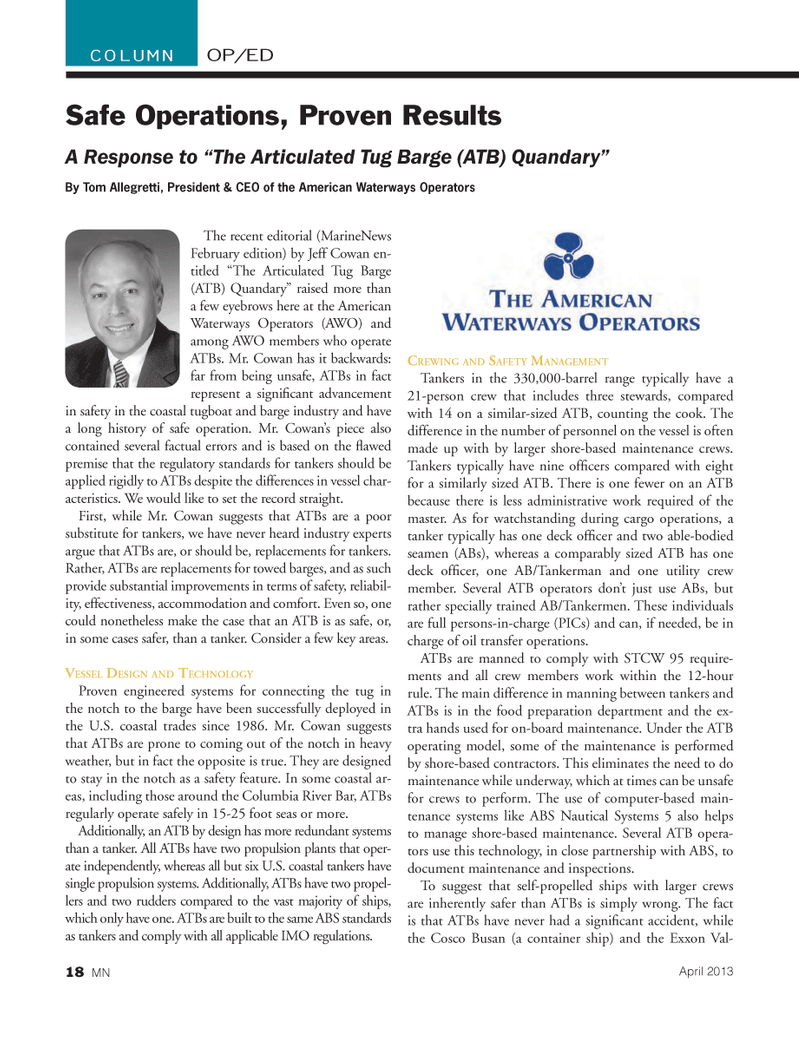
Page 18: of Marine News Magazine (April 2013)
Offshore Service Operators
Read this page in Pdf, Flash or Html5 edition of April 2013 Marine News Magazine
The recent editorial (MarineNews February edition) by Jeff Cowan en- titled ?The Articulated Tug Barge (ATB) Quandary? raised more than a few eyebrows here at the American Waterways Operators (AWO) and among AWO members who operate ATBs. Mr. Cowan has it backwards: far from being unsafe, ATBs in fact represent a signi cant advancement in safety in the coastal tugboat and barge industry and have a long history of safe operation. Mr. Cowan?s piece also contained several factual errors and is based on the awed premise that the regulatory standards for tankers should be applied rigidly to ATBs despite the differences in vessel char- acteristics. We would like to set the record straight. First, while Mr. Cowan suggests that ATBs are a poor substitute for tankers, we have never heard industry experts argue that ATBs are, or should be, replacements for tankers. Rather, ATBs are replacements for towed barges, and as such provide substantial improvements in terms of safety, reliabil- ity, effectiveness, accommodation and comfort. Even so, one could nonetheless make the case that an ATB is as safe, or, in some cases safer, than a tanker. Consider a few key areas. VESSEL DESIGN AND TECHNOLOGY Proven engineered systems for connecting the tug in the notch to the barge have been successfully deployed in the U.S. coastal trades since 1986. Mr. Cowan suggests that ATBs are prone to coming out of the notch in heavy weather, but in fact the opposite is true. They are designed to stay in the notch as a safety feature. In some coastal ar- eas, including those around the Columbia River Bar, ATBs regularly operate safely in 15-25 foot seas or more. Additionally, an ATB by design has more redundant systems than a tanker. All ATBs have two propulsion plants that oper- ate independently, whereas all but six U.S. coastal tankers have single propulsion systems. Additionally, ATBs have two propel- lers and two rudders compared to the vast majority of ships, which only have one. ATBs are built to the same ABS standards as tankers and comply with all applicable IMO regulations. CREWING AND SAFETY MANAGEMENT Tankers in the 330,000-barrel range typically have a 21-person crew that includes three stewards, compared with 14 on a similar-sized ATB, counting the cook. The difference in the number of personnel on the vessel is often made up with by larger shore-based maintenance crews. Tankers typically have nine of cers compared with eight for a similarly sized ATB. There is one fewer on an ATB because there is less administrative work required of the master. As for watchstanding during cargo operations, a tanker typically has one deck of cer and two able-bodied seamen (ABs), whereas a comparably sized ATB has one deck of cer, one AB/Tankerman and one utility crew member. Several ATB operators don?t just use ABs, but rather specially trained AB/Tankermen. These individuals are full persons-in-charge (PICs) and can, if needed, be in charge of oil transfer operations.ATBs are manned to comply with STCW 95 require- ments and all crew members work within the 12-hour rule. The main difference in manning between tankers and ATBs is in the food preparation department and the ex- tra hands used for on-board maintenance. Under the ATB operating model, some of the maintenance is performed by shore-based contractors. This eliminates the need to do maintenance while underway, which at times can be unsafe for crews to perform. The use of computer-based main- tenance systems like ABS Nautical Systems 5 also helps to manage shore-based maintenance. Several ATB opera- tors use this technology, in close partnership with ABS, to document maintenance and inspections.To suggest that self-propelled ships with larger crews are inherently safer than ATBs is simply wrong. The fact is that ATBs have never had a signi cant accident, while the Cosco Busan (a container ship) and the Exxon Val- Safe Operations, Proven Results A Response to ?The Articulated Tug Barge (ATB) Quandary? By Tom Allegretti, President & CEO of the American Waterways Operators OP/EDCOLUMN18 MNApril 2013MN April2013 Layout 18-31.indd 18MN April2013 Layout 18-31.indd 184/1/2013 11:28:58 AM4/1/2013 11:28:58 AM

 17
17

 19
19
